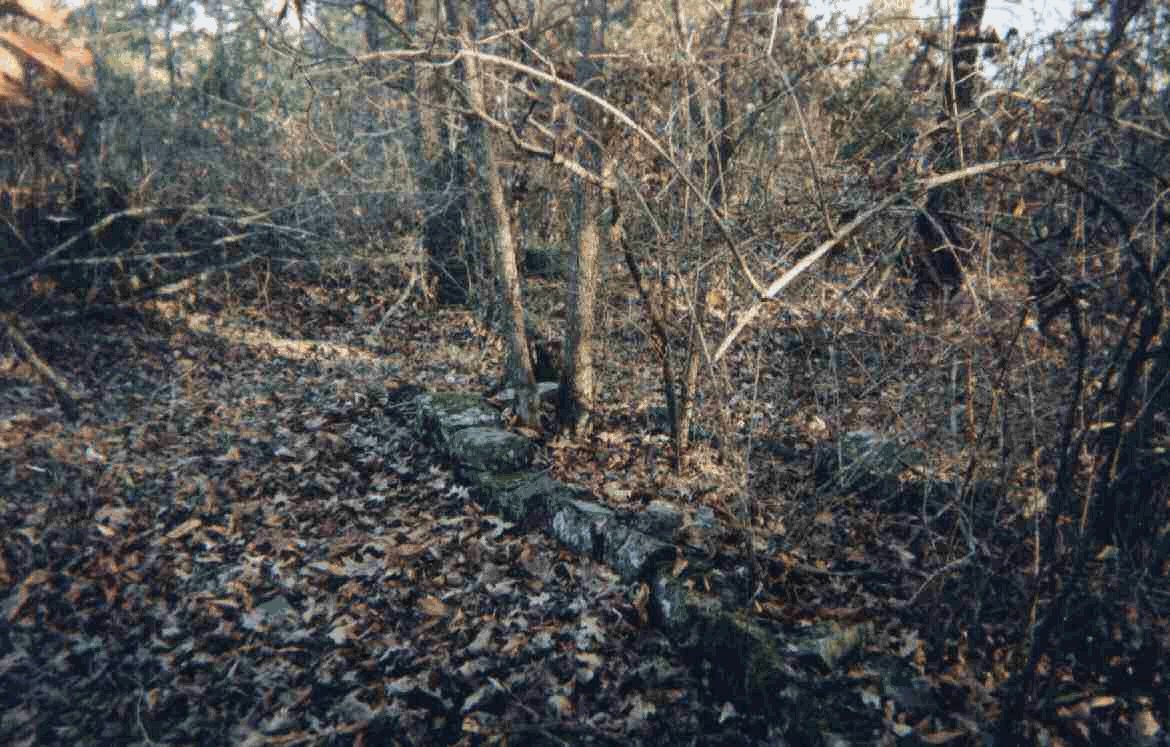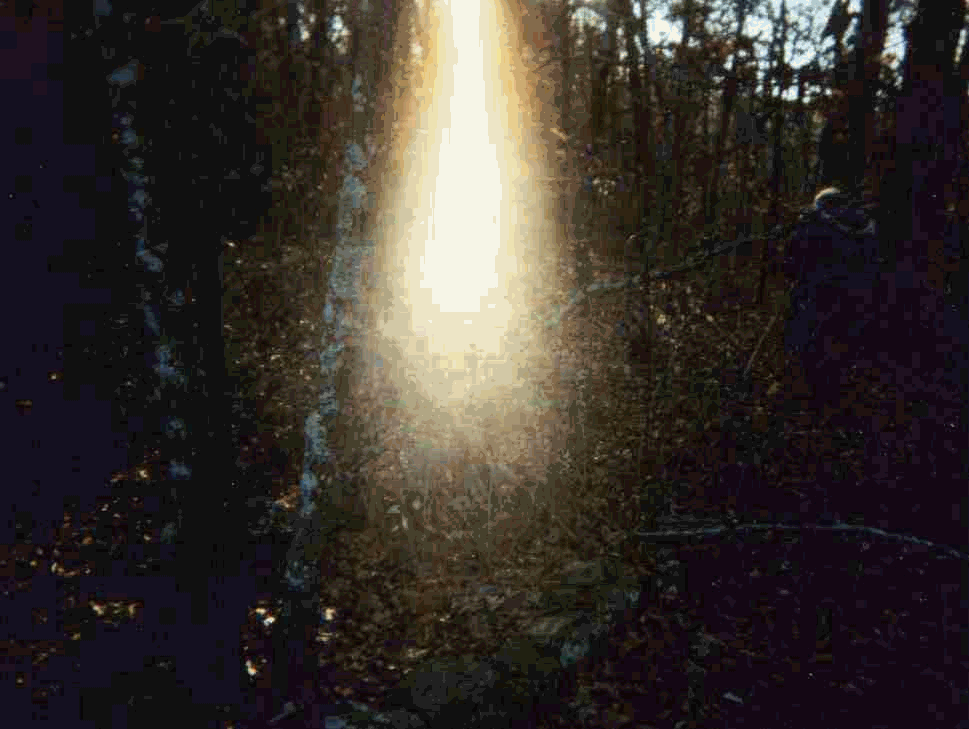

--photo by Leroy Blair, 2000
This ring of stones might be the final resting place of William Joseph Overstreet.
This cemetery, which has been the source of local legend for many years, was recorded November 27, 2000, by Leroy Blair of the White County Historical Society. The land is owned today by the Fredonia Cemetery Association. Blair, in an article that appeared on the front page of the December 17, 2000, edition of the The Daily Citizen of Searcy, said he was first told of the "old slave" graveyard while he was completing a survey of nearby Fredonia Cemetery.
A Bald Knob resident, Arnie Sanders, had reported the legend of the cemetery to Historical Society president Eddie Best September 7, 1999, but was not familiar with details. He said he had grown up at Holly Grove and had known it as "the old slave cemetery." He said his grandfather had told him that all of the descendents of these early slaves were "scared out" of the area by the Klan or other whites after the Civil War, some settling in nearby towns.
Blair was winding up a remarkable year, in which he surveyed more than 70 of White County’s cemeteries, when he wrote the following story for The Daily Citizen:
On November 27 of this year, I was listing the Fredonia Cemetery north of Judsonia when an elderly gentleman rode up on an ATV. We started talking, and he asked me if I knew anything about the old cemetery over the hill from where we were. I told him I had never heard of it. He said, "Go down Fredonia Road from Fredonia Cemetery to where it meets Stanley Road." The cemetery was on the right of Fredonia Road just before it runs into Stanley Road.
He said he had not been to it for about 20 years but believed it was about 100 feet back in the woods, that I would just have to look around back in there. He said the graves were marked only with rocks and some may have been moved to Fredonia Cemetery. The gentleman’s name was Ralph Sellers. He lives near there.
I followed his directions and found the old cemetery. I found 13 graves marked with rocks. One was enclosed with a rock ring. There appears to be about 20 depressions in the ground that are probably unmarked graves. There may be more. It is hard to tell, due to the large amount of leaves on the ground. I also found two deep holes in the ground where graves had probably been moved many years ago.
After I finished looking over the area, I called Mr. Sellers on my cell phone and asked him if he knew anything else about the old cemetery that might be of help to me. He said he did not, but that a Mrs. Kathryn Overstreet, who was a former caretaker for the Fredonia Cemetery, could probably help me. He told me where she lived, and I thanked him and went to see her. I found the elderly lady, who is in poor health. She told me the following story:
"In the early part of the 1860s, a Mr. Charles Mosley owned the land around there; he had a lot of slaves, and a bunch of Union soldiers were camped on the banks of Stevens Creek, which is near there. One night the soldiers came to the Mosley house with a lot of liquor and they and the slaves had a drinking party. The next morning when Mr. Mosley got up, he found the soldiers and all of his slaves dead in the yard from poisoned liquor. They were all buried there, and when Mr. Mosley died, he also was buried there, but was later taken up and moved to the Fredonia Cemetery at the request of his daughter." Mrs. Overstreet said that she had gotten this information from overhearing some people talking at a funeral many years ago.
Mrs. Overstreet told me of a man by the name of Freeman Mosley who owns the property where the old cemetery is located, and that he probably had more information on it than she did. I thanked her for her help and went home.
That night I was able to reach Mr. Mosley at his home by phone. He related the following version of what he knew about the old cemetery. He said that the man who owned the land and slaves was not Charles Mosley but Gideon Bullock, the father-in-law of Charles Mosley, and that the story of the slaves and soldiers was not exactly as Mrs. Overstreet had told me. He said that had been passed down through the families for generations. He said that in 1862 about 5,000 Union soldiers were camped on Stevens Creek waiting to attack Little Rock, and that some of the soldiers did give the slaves some liquor which was poisoned, and it killed the slaves. When Mr. Bullock got up the next morning he found the slaves dead and the soldiers gone. Mr. Mosley said that this is all hearsay passed down through the years. He does does not know how much of this is true. But then Mrs. Charles Mosley, daughter of Gideon Bullock, had his grave removed and was reburied in Fredonia Cemetery. [See FREDONIA CEMETERY.] He also said that he believed that all the white people, except for possibly the grave that was enclosed in the rock ring, have been removed to other cemeteries.
An area resident, Bob Wright, in a bylined article published in the Searcy Sun June 17, 2004, stated that this cemetery was originally called the Bullock Family Cemetery. He said he obtained his information in a telephone interview with Freeman Mobley, whom he identified as the great-grandson of Gideon Bullock. Wright stated that Gideon Bullock’s body was moved from this cemetery to nearby Fredonia Cemetery during the 1890s, and speculated that the burial of Martha E. Jowers on May 2, 1870, probably marked the beginning of Fredonia Cemetery. He added the following:
In 1855 Gideon Bullock migrated from North Carolina to Arkansas and purchased the land where the cemetery now exists from a soldier who fought in the War of 1812. Back then, the government gave land to soldiers as a bonus for joining the war effort. Bullock’s family later donated approximately three acres of land to establish the original cemetery. In August of 1937, the C.H. Gwatney family donated another acre to the land, followed by a 1976 donation from Mae Sterling of another acre. In 2004, Freeman Mobley donated another 6.12 acres to the cemetery to be named the Wilma Mosely Bullock Mobley Addition. Today, the Mobley and Mae Sterling additions of the cemetery are separated by four acres owned by the Lowell Bone family…

The Old Slave Cemetery is located on the newly donated Mobley addition… Leroy Blair … stated that he believes that all of the white people, except for one that is enclosed by a rock ring, have been moved to other cemeteries. In a conversation with my aunt Winnie Galloway, she stated that "Mary Wright told me that her great-grandfather was buried in the Old Slave Cemetery." Also, Minnie Mae Overstreet stated that Theodore Mosley told her that a Mr. Overstreet was buried in the Old Slave Cemetery. Due to this information and the statement by Leroy Blair that the only white person left in the Old Slave Cemetery was buried in the rock ring grave, I believe this person to be William Joseph Overstreet, who was born on April 9, 1804, and died October 28, 1964. Since Mr. Overstreet’s wife, Annie Caroline Jumper Overstreet, and their children are listed as being buried in Fredonia Cemetery and he is not, this also leads me to believe that he is the one in the rock ring grave. Mr. Overstreet would be my great-great-great grandfather.
BLAZE OF GLORY? With daylight fading fast and darkness falling over the woodland site of the Old Slave Cemetery, Leroy Blair took one last photograph. When his film was developed and prints delivered a few days later, he was baffled by this eery light on the final shot. Just a light leak? It has never happened before with his camera, Blair said.